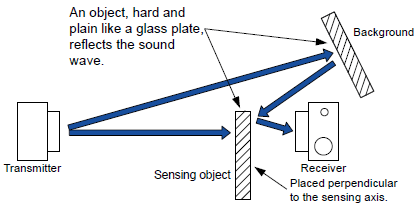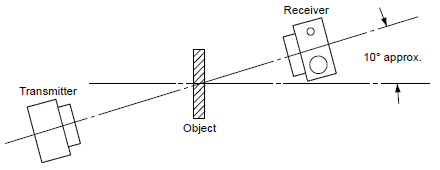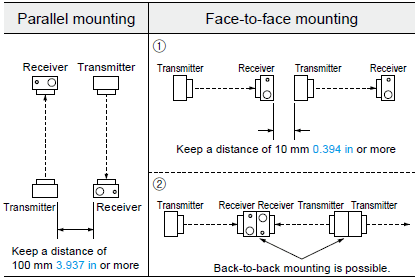Thru-beam Type Ultrasonic Sensor US-N300 (Discontinued Products)
We are sorry, the products have been discontinued. Please refer to the details of the discontinued products and the recommended substitutes list below.
 |
June 30, 2023 |
|
|
Cautions For Use
- Never use this product as a sensing device for personnel protection.
- In case of using sensing devices for personnel protection, use products which meet laws and standards, such as OSHA, ANSI or IEC etc., for personnel protection applicable in each region or country.
Mounting
- The tightening torque should be 0.49 N·m or less.
Sensitivity adjustment
- Normally, use the sensor at the maximum sensitivity.
However, if the sensing is not proper due to surrounding objects (reflection from surrounding objects, etc.), adjust the sensitivity.
Influence of surrounding objects
Influence of an object parallel to the sensing axis
- If there is a wall or a curtain near the sensing axis, the sound reflection may cause the operation to be unstable.
<Countermeasure> |
 |
|
Influence of background objects
- If sensor heads are installed as shown in the figure below, the operation may become unstable by the reflected sound wave.
|
 |
|
<Countermeasure>
- The receiver should be placed away from the object and at an angle to it as shown below.
|
 |
|
Mutual interference
- When two or more sensors are mounted close together, the sensors may not enter the “sound-blocked state” due to mutual interference.
<Countermeasure>
Traveling speed and minimum sensing object width
- Minimum sensing object width is 20 × 20 mm 0.787 × 0.787 in in the stationary condition.
The minimum sensing width of a traveling object is
related to the traveling speed and the sensor response
time by the following formula.
W=VT+A(m)
| W: |
Minimum sensing object width(m) |
| V: |
Traveling speed of the object (m/sec.) |
| T: |
Sensor response time = 0.005 (sec.) |
| A: |
Minimum sensing object width in the stationary condition = 0.02 0.066 (m ft) |
(Example) V=10m 32.808 ft /sec.
W=10 32.808 × 0.005 0.016 + 0.02 0.066
=0.07 m 0.230 ft
=70 mm 2.756 in
Others
- Do not use during the initial transient time (50 ms) after the power supply is switched on.
- The ultrasonic sound propagates through the air. If the sensor is used at a place where air blows or the temperature suddenly changes (near a door, an air conditioner, etc.) the operation may become unstable. Avoid using US-N300 at such places.
- Take care that the sensor may malfunction due to an intense extraneous sound, such as, metal impact sound.
- Do not expose the transmitting element or the receiving element to moisture or dust. It may affect the sensing operation.
Return to top
Return to top
 Business
> Industrial Devices
> Automation Controls Top
> FA Sensors & Components
> Sensors
> Particular Use Sensors
> Thru-beam Type Ultrasonic Sensor US-N300(Discontinued Products)
> Cautions For Use
Business
> Industrial Devices
> Automation Controls Top
> FA Sensors & Components
> Sensors
> Particular Use Sensors
> Thru-beam Type Ultrasonic Sensor US-N300(Discontinued Products)
> Cautions For Use











